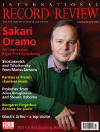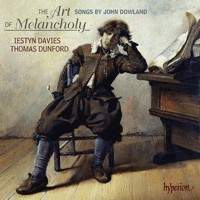Texte paru dans: / Appeared in:
*

International Record Review - (07-08//2014)
Pour
s'abonner / Subscription information
Hyperion
CDA68007

Code-barres / Barcode
: 0034571280073 (ID432)
Consultez toutes les évaluations recensées pour ce cd
~~~~ Reach all the evaluations located for this CD
John Dowland was the most flamboyantly melancholic musician of his time,
when melancholy was a fashionable condition. Some, such as Robert Burton in
his Anatomy of Melancholy (1621), ascribed many causes to, it,
including the political and religions uncertainties of the age and marked
social change. They also identified frustrated ambition (a natural
concomitant of an age of political insecurity) as another cause.
Interestingly, the difficult, tactless and mistrustful Dowland may also have
been one of the most professionally frustrated musicians in England for,
despite his international fame, almost unique for an English lutenist of the
time, it was only after many failed attempts and years of professional
(albeit well‑remunerated) exile that he finally won his much‑coveted
position at the English court.
The countertenor Iestyn Davies
believes that Dowland probably suffered from genuine depression. This
explains some of his interpretative choices in this recital; but it is
generally accepted that Dowland's melancholy was largely an artistic pose.
Dowland's contemporaries regarded sad music as, paradoxically, an antidote
to melancholy. As Burton put it, 'Many men are melancholy by hearing Musicke,
but it is a pleasing melancholy that it causeth, and therefore to such as
are discontent, in woe, feare, sorrow, or dejected, it is a most present
remedy, it expells cares, alters their grieved mindes, and easeth in an
instant.'
It is the 'care‑ and
grief‑easing' character of Dowland's songs that makes them such profound and
pleasurable listening. Davies and his young colleague, the lutenist Thomas
Dunford, have selected a rich collection of Dowland's most melancholy and
most masterful songs, including favourites such as Flow, my tears and
Sorrow, stay. Their recital demonstrates once again that, although
Henry Purcell was a more universal musical genius, Dowland surpassed him as
a song writer.
Davies and Dunford open with
Sorrow, stay and close with Now, oh now I needs must part
and the ordering of the rest of the songs reflects their thoughtful
approach. As heard already in recent recordings, Davies's vocal technique is
impressively secure (especially in the long‑breathed, almost suspended
phrases Dowland so loved) and lie overcomes a certain lack of tonal variety
through intelligent phrasing and articulation. Occasionally, his fluttery
vibrato on some notes is a little unsettling, especially after lengthy
lyrical passages of unwavering purity, but these moments hardly detract from
his refined and delicately shaped performances. The one song in which lie is
not quite successful is the most famous, Flow, my tears. His
is a rather maudlin rendition, perhaps resulting from his views about
Dowland and depression.
Another welcome feature of
Davies's singing is ornamentation, which is a comparative rarity in Dowland
song recordings. He generally confines his embellishments to the strophic
songs. Just occasionally, such as in the last verse of Come again,
lie sings an unidiomatic trill that sounds more like Porpora than Dowland,
revealing that, despite the polish of his performances, his journey of
discovery of Dowland has only recently begun.
Dunford, for his part,
combines in his lute playing an enviable technical facility and an artistic
insight beyond his tender years. His handful of solos on the disc, as much
as his song accompaniments, are models of precision allied with incisive
emotionaI perceptiveness. At the centre of the programme lie plays a solo
longer than any of the songs, the punningly emblematic Semper Dowland
semper dolens ('Always Dowland always mournful'), with flawless control
and heartfelt expression. Equally impressive is his account of the
emotionally complex Lachrimae and the rather jollier Mrs Winters
Jump.
However, it
seems Dunford has selected a very unorthodox instrument for this disc. No
explanation is provided in the booklet, which merely describes his
instrument as 'lute'. His photograph shows him holding what appears to be an
archlute, a larger form of the instrument whose range in the bass was
extended by the addition of unstopped strings attached to a long neck
extension. It seems this is the instrument he uses on this disc, since its
unstopped bass strings can be heard resonating sympathetically as he plays
and it has a brasher and longer‑sustaining sound than a conventional
double‑strung seven or eight‑course lute of the kind Dowland would have
used. In the hands of a less skilled player, this could have resulted in an
imbalance between voice and lute. Thankfully that is not the case here,
although this choice may surprise lute fans.
The sound quality of the
recording, made in Potton Hall in Suffolk, is exemplary in its clarity and
naturalness. For this review, in addition to the physical disc, Hyperion
provided the high‑resolution (24 bit, 96 kHz) 'studio master' download
version in FLAC format available from its website. Played on my hi‑fi
system, this version located the musicians more clearly within the recording
space and heightened especially the immediacy of the lute, although the
difference is subtle.
Cliquez l'un ou l'autre
bouton pour découvrir bien d'autres critiques de CD
Click either button for many other reviews


